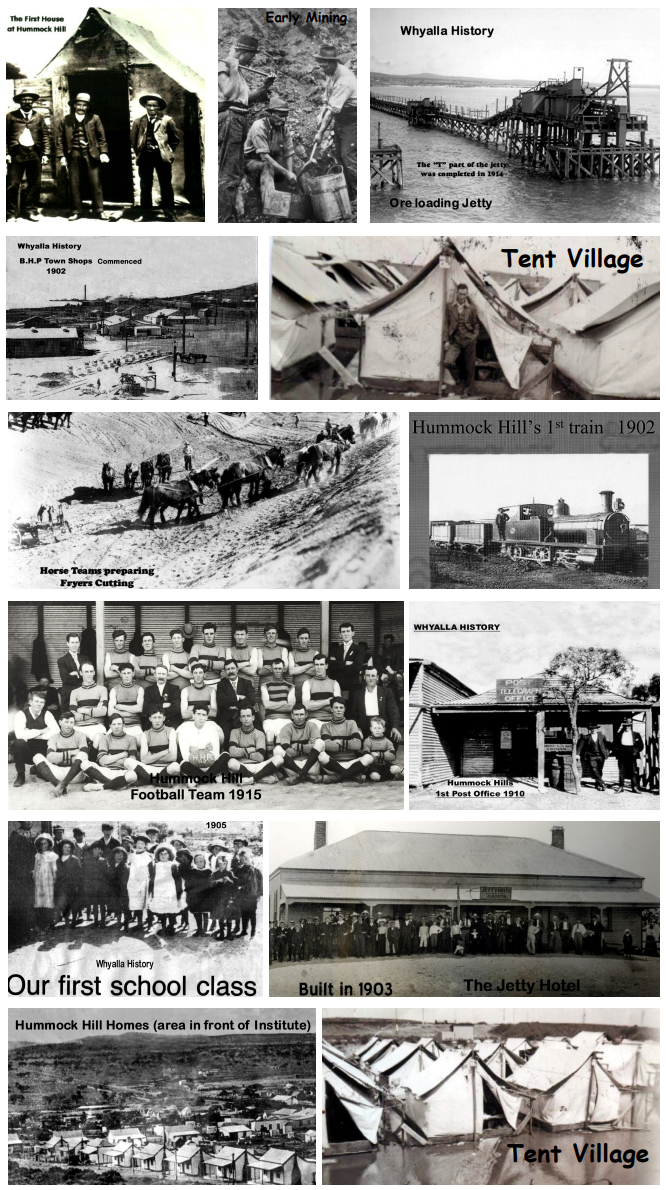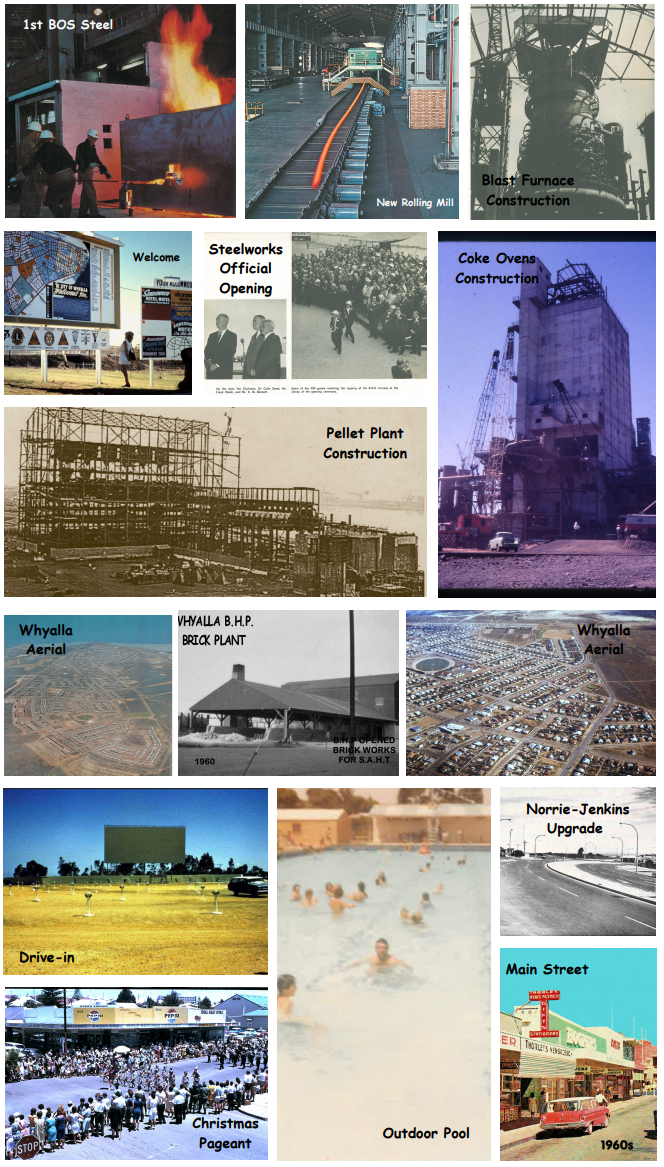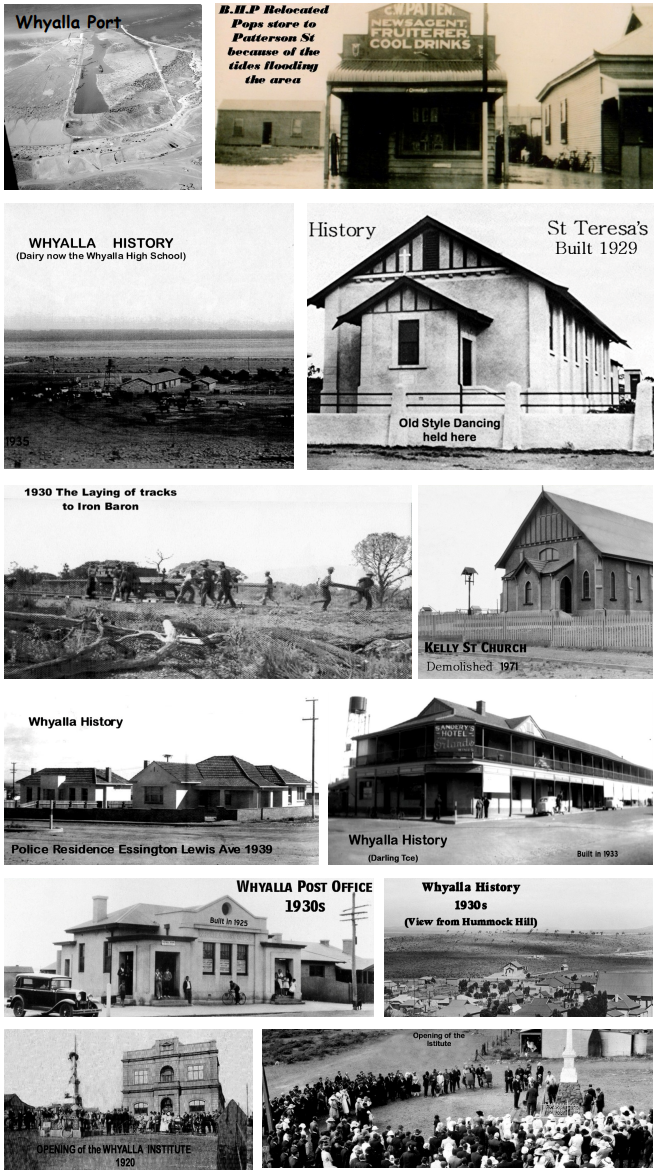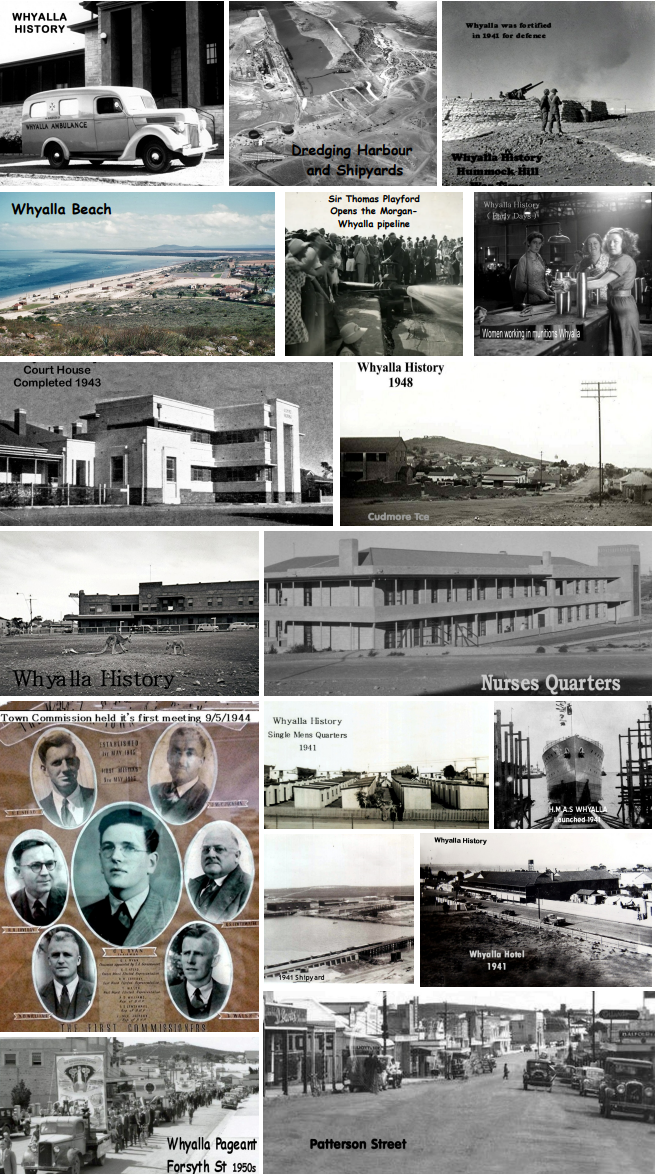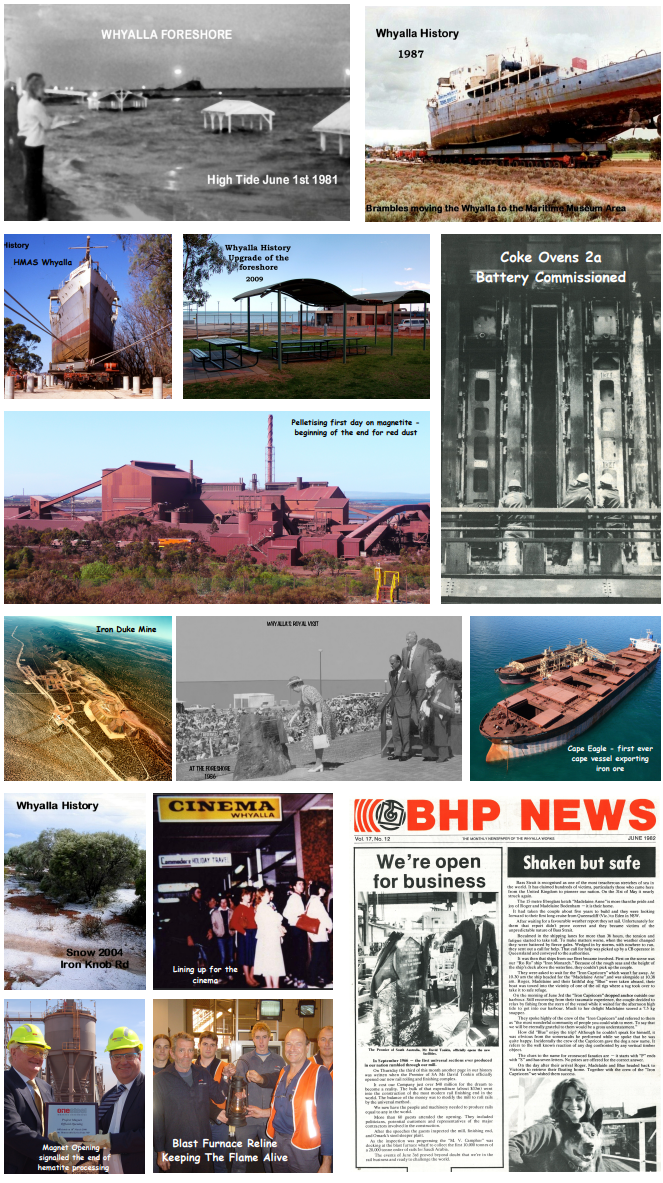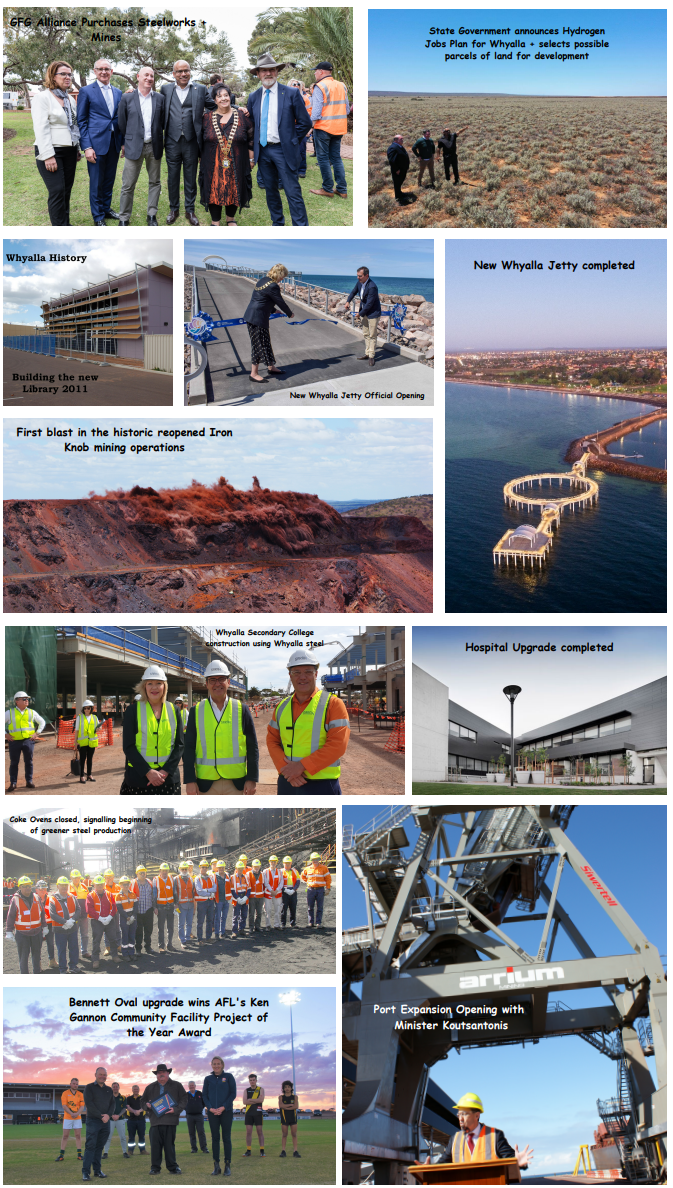The original Aboriginal owners of the land have documented the previous 40,000 years in their Dreaming. However, all of Australia's post European history, from the first settlement at Sydney Cove until today, is crammed into around 225 years. The residents of Whyalla have a similar, if not more hurried and compacted history.
Hummock Hill, a small rise on the western shores of Upper Spencer Gulf, was named by Matthew Flinders on 9 March 1802. The catalyst for the early European settlement, and the eventual explosion in population after World War ll, was the discovery of iron ore at Iron Knob in the mid 1800's.
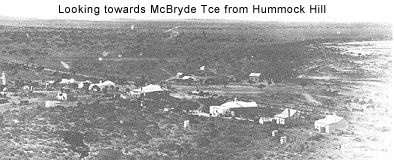
The then Broken Hill Proprietary Company Limited (BHP) acquired leases to work ore in the region in November 1899, as iron ore could be used for flux in the company's smelter in Port Pirie. In January of 1901, men began arriving from Port Pirie to build a tramway to the ore deposits at Iron Knob, and the town of Hummock Hill was born. The construction of a jetty to load the ore onto barges begun and by the end of the year the population of the town was almost 50.
For a long period, Hummock Hill was a small , remote settlement and shipping port concentrated around the base of the hill. Some of the population lived in tents and the houses that did exist were constructed of basic materials. Popular methods of cladding houses were flattened kerosene tins or whitewashed wheat bags.
The few roads in the town were unsealed, but there were no cars to drive on them anyway - transport was still by horse and cart. Water was brought from Port Pirie in barges and sold for two shillings per 100 gallons. A small store opened in 1903 at the end of McBryde Terrace and a community hall was built in 1905 at Hummock Hill in which the first school opened.
1910 - 1940
The town became less isolated in 1911 when the first telephone service was installed. Hummock Hill became Whyalla when the town was officially proclaimed on 16 April 1914 and Whyalla's first policeman arrived three weeks later. The following year, the ore conveyor belt on the jetty became operational and more ore was able to be loaded onto the ships. BHP had begun to build a steelworks in Newcastle and the ore produced at Iron Knob way was now being sent there to produce steel.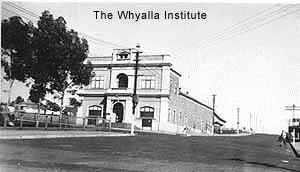
In the following years, Whyalla's population grew slowly but steadily, and by 1920 it had reached approximately 1,000. The facilities that were the central focus of country towns, of this time, were beginning to appear. The Whyalla Institute on the corner of Jamieson and Gay Streets was opened by Mr G E Delprat on 3 November 1920 and the Kelly Street church was built. Sporting associations were being formed, as well as an RSL sub-branch. In subsequent years BHP provided a dairy, a new power house, a desalination plant and a power line to Iron Knob. The Whyalla Brass Band was formed, the first bank opened and a freight service to Adelaide began.
Most of this development took place at the immediate base of Hummock Hill, in an area bounded by Gay and Horwood Streets to the south and McBryde Terrace to the north. A large part of this early section of town no longer exists, with little evidence of where it had been.
Eighteen years later, in 1938, the town's population had only grown by another 400 residents, but the catalyst for a rapid increase had already been set in place the year before. The BHP Indenture Act was proclaimed in 1937 and an area of land was set aside for the construction of a blast furnace and harbour. Concern was expressed about the shortage of water at the site and negotiations with the SA Government resulted in the commitment for the construction of a pipeline from the River Murray.
As construction of the harbour and blast furnace commenced in 1939, world tensions were rising with the imminent outbreak of World War ll. The Royal Australian Navy asked BHP if they were able and willing to build patrol ships, and so the construction of shipyards next to the blast furnace site was also to begin. All of this work required labour and the influx of workers into the town saw the population rise drastically, as did businesses and facilities for the residents. In 1940, the Whyalla Hospital, the Whyalla Abattoirs, the RAOB Hall, the Ozone Open Air Cinema, St Teresa's School, and the Bayview and Spencer Hotels were all opened or being built. The Whyalla News was established, and the shipyards began work.
1940 - 1960
In 1941, the first ship built in the new BHP shipyards, the corvette HMAS Whyalla, was launched. The blast furnace became operational and BHP began making shells for the war effort. Hummock Hill was fortified with the installation of four 3.7 inch heavy anti-aircraft and coastal defence guns, supported by a shipping identification signalling position. By 1943, Whyalla's population had soared to more than 5,000. The same year, a new police station, court house and technical school were built and opened. Until now, Whyalla was a company town and all services had been provided by BHP, but the residents were starting to give serious thought to how the town was being run. A public meeting was held in 1943 to discuss local government.
On 31 March 1944, an important event occurred in the town's history - the Morgan to Whyalla pipeline was opened. The ready availability of water now enabled industry and the population to grow at an ever-increasing rate. The following year on May 9, the newly formed Town Commission held its first meeting. Consisting of three elected members, three BHP appointed members and a government appointment Chairman Charles Ryan, the Commission provided Whyalla's first form of local government.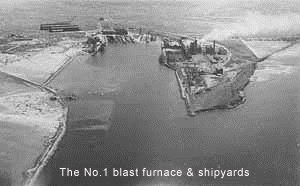
The end of the war in 1945 was to bring yet more change to the fledgling town. BHP no longer needed to build naval ships and started building commercial vessels. The war had left large numbers of refugees in Europe and the Australian Government had adopted a policy of increasing skilled migration to Australia. The first group of displaced persons' from Europe arrived in Whyalla in 1948. They moved for many reasons, but were generally coming for a new life.
The 15 years from the end of the war until 1960 saw many of the town's facilities being built and community organisations start up. The Pacific Open Air Cinema, Memorial Oval, a new airport, Whyalla West School, Trades Hall, cycling velodrome and the CWA Hall were all opened during these years. The Whyalla Garden Society, Whyalla Music Club, Whyalla Rostrum Club, Whyalla Rotary Club, Whyalla Apex Club, Whyalla Players, Whyalla Surf Lifesaving Club, Northern Naturalists, and YMCA were formed. Whyalla had also "arrived" socially, with visits by the Duke and Duchess of Gloucester, and Queen Elizabeth ll and Duke of Edinburgh.
1960 - 1980
In 1958, BHP announced the decision to build an integrated steelworks at their site in Whyalla. This decision was influenced by the State Government of Thomas Playford, which they were keen to see ore mined in South Australia and processed in the State as well. New workers flooded into town, and Whyalla continued to expand to the west to accommodate the rising population, which by 1961 had reached 14,076.
On 1 November that year, Whyalla was proclaimed a City and the next month the Town Commission moved into the new Civic Building on Darling Terrace.
The next 18 years saw exponential growth in the city. By 1962, BHP was employing 2,301 staff at the steelworks and 1,407 at the shipyards. The South Australian Institute of Technology (now the University of South Australia), Bennett Oval, Whyalla Bowl, Ambulance Centre, Foreshore Motel, Outdoor Swimming Pool and Darling Terrace Post Office were built during 1965. In May of that year, the Whyalla Steelworks were declared open by Premier Frank Walsh.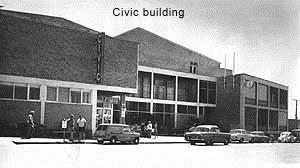
The first consignment of exported steel blooms left BHP for Spain in 1966, the company started harvesting salt and the construction of the coke ovens began. In anticipation of increased demand for water, a second pipeline from Morgan was being constructed. This time the pipe was laid under Spencer Gulf and water flowed through it for the first time in October. The census on 30 June revealed that the population had reached 22,126, an increase of 8,050 in the previous five years, To cope with this rise in population, the South Australian Housing Trust was building houses at a rate of 500 a year.
In 1967, the suburbs of Whyalla were officially named Whyalla, Whyalla Playford, Whyalla Norrie and Whyalla Stuart. The city continued to grow westward and the significant Westland Shopping Centre was built in the geographical centre of Whyalla near the Mount Laura Homestead Museum - originally the old homestead of Mount Laura Station.
The construction of the Whyalla Steelworks was finally completed in 1968, when the pellet plant and the coke ovens both began operation. Estimates of the population in that year show it continuing to soar, increasing by approximately 6,000 in the previous two years to 28,150. The workforce of BHP in 1970 had now reached 6,950. Preliminary planning by the Department of Lands was now allowing for a city to 100,000 people.
However, due to the ship-building slump in the 1970's, the Whyalla Shipyards closed down in 1978, at the same time as a worldwide downturn in the steel industry. The city, after a population peak of 33,000 in 1976, reeled from this shock and rapidly decreased its numbers.
Photos by decade
